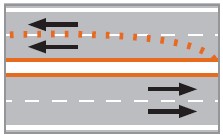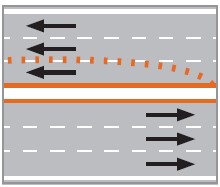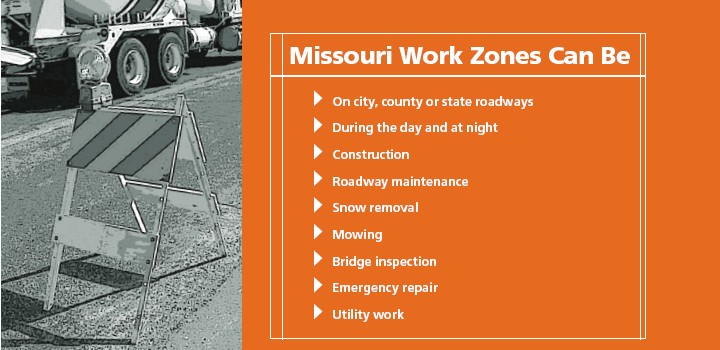616.25 MoDOT Work Zone Guidelines
| MoDOT Work Zone Guidelines |
|---|
MoDOT has changed its statewide work zone guidelines to improve safety for motorists and highway workers, reduce traveler delays and frustrations, improve statewide consistency in work zones and make better use of MoDOT’s resources.
| Work Zone Coordinators |
| Work Zone Coordination contacts |
With limited funding and a deteriorating transportation system, MoDOT is focusing more of its resources on preservation and maintenance. Because of this, more work is being done in traffic, meaning more possible conflicts between motorists and workers, as well as more possible delays for motorists.
As a result of our efforts, 25 percent of reported lane closures in 2003 were scheduled during off-peak hours; night work was used on 87 projects; 26 projects used road closures to speed up the project completion time; better scheduling of lane closures occurred through the development of a statewide lane-closure notification system; and work during hours with capacity restrictions has been minimized through an online application that calculates hourly traffic volumes.
The new guidelines focus on:
- SAFETY: It’s our No.1 value
- CONVENIENCE: We’ll reduce disruptions for motorists by:
- Shifting work to night and off-peak hours, when possible
- Managing multiple projects on a route at one time
- Setting appropriate speed limits
- COMMUNICATION: We’ll get the word out about upcoming projects and alternate routes.
Strategies to Improve Work Zones
There are many ways MoDOT is making work zones safer, while reducing delays and decreasing motorists’ frustrations. The department is focusing on three key strategies to improve work zones for highway workers and motorists.
1. Ensuring appropriate and consistent work zone speed limits are used to reflect actual conditions
- Improved guidelines ensure proper posting and clarify expectations
- Speed-limit reductions will be removed when conditions change (i.e., lane closure removed, workers not present, etc.)
- Appropriate warning signs will be used for specialized safety considerations (i.e., curves, lane width, etc.)
2. Ensure MoDOT and contractors’ staff are working during off-peak hours
- Hourly volume tables should be used to determine when to work off-peak hours
- Staff should use off-peak work-hour guidelines when scheduling lane closures
- Nighttime or weekend work may be required, when necessary
- Consider statewide effects of special events along major routes
3. Implement better quality control and quality assurance measures in work zones
- Ensure lane drops are removed, when no longer needed
- Ensure all work zone traffic-control devices are placed properly
- Ensure all work zone traffic-control devices are kept clean, repaired or replaced when necessary and have adequate reflectivity
| Now is the time to change how we think about work zones |
|---|
Statewide Work Zone Coordinator
The statewide work zone coordinator organizes lane closures and oversees work zones on the National Highway System so traffic runs smoothly, safely and effectively with the least amount of inconvenience to motorists. Responsibilities include:
- Coordinating lane closures across district boundaries and across the state
- Considering the statewide impact of work zones to traffic
- Ensuring the statewide traffic effects of major sporting events, the state fair and other special activities are considered when planning work zones
District Work Zone Coordinators
Each of MoDOT’s seven districts have a work zone coordinator to organize lane closures within their district, and ensure work zones in their area run smoothly, safely and effectively with the least amount of inconvenience to motorists. Each district engineer supports the work zone coordinators and ensures they implement these guidelines internally and externally. District work zone coordinator responsibilities include:
- Scheduling lane closures during off-peak and/or nighttime hours when possible, when traffic volumes exceed 75 percent to 80 percent of the open-lane capacity
- Scheduling work on multiple projects on the same route
- Working with Project Development to ensure that working days for projects requiring lane closures will be reduced, when possible
- Notifying the statewide work-zone coordinator before any lane closures on the National Highway System
- Using hourly volume tables to determine if lane closures will result in capacity traffic levels in the open lanes
- Collecting all proposed roadway project work from district staff
- Reviewing all maintenance and internal work zone activities requiring lane closures
- Reviewing all commercial and utility/permit work zone activities requiring lane closures
Project Award
Before any project is awarded, the project core team will review it to ensure MoDOT is taking the appropriate actions to reduce work zone effects on the public. The project manager will conduct traffic analyses to ensure the following actions minimize traffic impacts:
- Scheduling lane closures during off-peak and/or at nighttime hours, when possible
- Using incentive/disincentive contracting and other bidding options, when possible, to reduce project completion time
- Evaluating and implementing schedules to reduce the number of working days needed to complete projects quicker
- Using road closures and/or signed detours, when possible, to complete projects quicker
- Opening additional through lanes to reduce traffic effects
- Ensuring work zone speed limits are appropriate in active and non-active work zones
MoDOT Roadway Maintenance and Activities
The district work zone coordinator reviews all maintenance and internal work zone activities requiring lane closures to reduce the work zone effects on motorists. The district engineer ensures the appropriate district staff considers the following actions when scheduling lane closures:
- Notifying the district work zone coordinator 48 hours before beginning any non-emergency work requiring a lane closure
- Scheduling lane closures during off-peak and/or nighttime hours, when possible
- Ensuring work zones are maintained in a neat, orderly and effective manner for the safety of highway workers and motorists
- Scheduling multiple tasks in a single work zone, rather than scheduling multiple lane closures in the same area
- Making every effort to minimize traffic backups
- Ensuring the appropriate traffic-control equipment is used
- Ensuring work zone speed limits are appropriate in active and non-active work zones
Commercial Utility/Permit Work
The district work zone coordinator reviews all commercial and utility or permit projects to reduce work zone effects on motorists. The permit staff ensures the following actions are considered:
- Notifying the district work zone coordinator 48 hours before any work requiring a lane closure begins
- Scheduling lane closures during off-peak and/or nighttime hours, when possible
- Inspecting all work zones and ensuring traffic-control plans are implemented, or work will halt
- Ensuring work zones are maintained in a neat, orderly and effective manner for the safety of highway workers and motorists
- Scheduling multiple tasks in a single work zone, rather than scheduling multiple lane closures in the same area
- Making every effort to minimize traffic backups
- Ensuring work zone speed limits are appropriate in active and non-active work zones
Active Construction-Project Work Zones
The appropriate MoDOT resident engineer reviews all active construction work zones. The district engineer ensures the following actions are taken:
- Notifying the district work zone coordinator in accordance with contract specifications before any work requiring a lane closure begins
- Working with the contractor to ensure lane closures are minimized
- Making every effort to minimize traffic backups
- Ensuring all contract specifications, special provisions and work restrictions are enforced
- Ensuring all work zones are neat, orderly and effective for the safety of highway workers and motorists
- Ensuring work zone speed limits are appropriate in active and non-active work zones
| Least amount of delay to the motorist |
|---|
Roadway Capacities
- Hourly Volume Tables
- To obtain hourly volume tables, contact the district work zone coordinator.
- Keep Missouri Moving Safely in Work Zones
- You can help reduce the number of those injured and killed in work zone crashes.
- Plan your trip. Contact MoDOT for lane closure information.
- Stay alert.
- Drive courteously.
- Obey work zone sings and flaggers' instructions.
- Be patient. Work today results in smoother roads tomorrow.
Interstates and Freeways
Interstates and freeways are high volume multiple-lane routes divided by medians. These routes carry the largest volumes of traffic, and depending on the number of lanes, can affect thousands of vehicles per hour. By using the appropriate work zone guidelines on these roadways, the biggest work zone improvements can be made. The Highway Capacity Manual provides traffic-capacity information for urban freeway work zones. This information may also be used for rural freeways and interstates.
The most common interstate and freeway work zone situation in Missouri is on a route with two lanes per direction, with one closed lane. This results in a maximum traffic capacity of 1,240 vehicles per hour. Strategies to reduce effects on the motoring public should be considered when traffic volumes approach 1,000 vehicles per hour per lane.
Where there are three lanes in one direction and one is closed, or where there are four lanes with one or two of those closed, the open-lane capacity is approximately 1,450 vehicles per hour. Strategies to reduce effects on the motoring public should be considered when traffic volumes approach 75 percent of the restricted capacity, or 1,100 vehicles per hour. Where there are three lanes in one direction and two are closed, the maximum capacity is approximately 960 vehicles per hour and strategies should be considered when traffic volumes approach 750 vehicles per hour per lane.
The greatest traffic reductions per lane occur when the situation is most restricted. For instance, if there are five lanes in one direction and three are closed, the capacity of the two open lanes is 1,320 vehicles per hour per lane. Strategies to reduce effects on the motoring public should be considered when volumes approach 75 percent of the restricted capacity, or 1,000 vehicles per hour per lane.
Multilane Roadways
Multilane roadways also have more than one lane per direction, however, because most do not have medians, they must be treated differently than interstates and freeways.
The work zone capacity of multilane roadways is approximately 1,000 vehicles per hour per lane. Strategies to reduce effects on the motoring public should be considered when volumes approach 80 percent, or 800 vehicles per hour per lane.
Two-lane Roadways
Work zones for two-lane roadways need to be reviewed on a case-by-case basis. Although these routes have the lowest traffic volumes, they also do not have medians and may have narrower shoulders and more curves than higher-volume routes.
Strategies to reduce effects on the motoring public should be considered when volumes approach 600 vehicles per hour per lane.
Roadway Capacities







